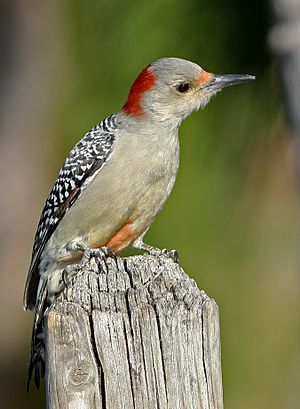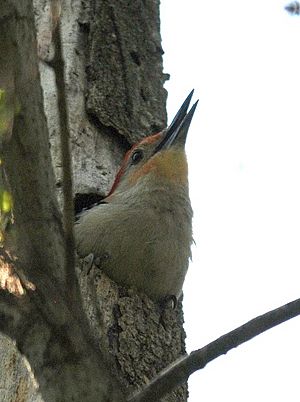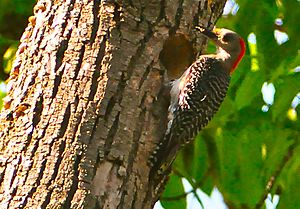Red-bellied woodpecker facts for kids
Quick facts for kids Red-bellied woodpecker |
|
|---|---|
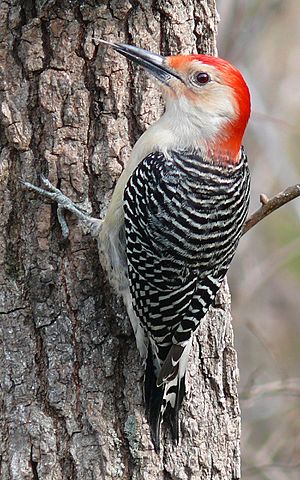 |
|
| Adult male | |
| Conservation status | |
| Scientific classification | |
| Genus: |
Melanerpes
|
| Species: |
carolinus
|
 |
|
| Range of M. carolinus | |
| Synonyms | |
|
Centurus carolinus |
|
The red-bellied woodpecker (Melanerpes carolinus) is a medium-sized woodpecker. It belongs to the Picidae family. These birds mostly live in the eastern United States. You can find them as far south as Florida and as far north as Canada. Even though it's called "red-bellied," the brightest red part is actually on its head! Another bird, the red-headed woodpecker, is a close relative but looks quite different.
Contents
Scientific Classification
The red-bellied woodpecker was first described by an English naturalist named Mark Catesby. He wrote about it in his book, The Natural History of Carolina, Florida and the Bahama Islands, published between 1729 and 1732. Catesby called it "The Red-bellied Wood-pecker."
Later, in 1758, a Swedish scientist named Carl Linnaeus gave it the scientific name Picus carolinus. This was part of his famous book, Systema Naturae. Today, the red-bellied woodpecker is one of 24 species in the group called Melanerpes. This group was named by an English bird expert, William Swainson, in 1832. There are no different types (subspecies) of this woodpecker.
What They Look Like
Adult red-bellied woodpeckers have light gray faces and undersides. Their backs, wings, and tails have cool black and white stripes.
- Males: Have a red cap that goes from their beak all the way to the back of their neck.
- Females: Have a red patch on the back of their neck and another small red spot above their bill.
It's actually pretty hard to see the reddish color on their belly. That's why their name can be a bit confusing! These woodpeckers are about 9 to 10.5 inches (23 to 27 cm) long. Their wings can spread out about 15 to 18 inches (38 to 46 cm). They weigh about 2 to 3.2 ounces (56 to 91 grams).
Sounds They Make
Red-bellied woodpeckers are known for being quite noisy birds! They have many different calls. Some of their calls sound like churr-churr-churr or thrraa-thrraa-thrraa. They also make an alternating br-r-r-r-t sound.
Males usually call and drum more often than females. But both sexes make sounds. Their drumming sounds like about six quick taps. Woodpeckers often "drum" to find a mate. They tap on hollow trees, and sometimes even on metal roofs or streetlights in cities! Baby woodpeckers make a high-pitched pree-pree-pree sound. They keep making this sound to ask for food even after they leave the nest.
Life and Habits
These birds mostly look for arthropods (like insects) on tree trunks. They can also catch insects while flying. Red-bellied woodpeckers are omnivores, meaning they eat both plants and animals. Their diet includes insects, fruits, nuts, and seeds.
They prefer to live in deciduous forests, which are forests where trees lose their leaves in the fall. They build their nests inside holes they dig in dead trees. They also use old tree stumps or softer live trees like maples. Both the male and female help dig the nest hole. They even make drilling holes around their nest to tell other birds to stay away!
Even though this woodpecker species is not in danger, it needs large trees for nesting. In places where many trees are cut down, these birds might try to use gardens. But mostly, they won't be found in large numbers in deforested areas.
Reproduction and Family Life
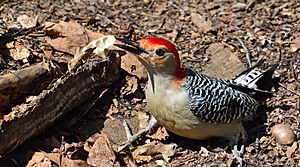
In early May, red-bellied woodpeckers start their breeding season. They use drumming patterns to attract mates. This includes slow taps followed by quick drumming. They also use special calls to communicate with potential partners. A soft "grr, grr" sound is heard between a pair from when they first meet until the end of the breeding season.
If two woodpeckers are fighting over a mate, they often make a loud "chee-wuck, chee-wuck, chee-wuck" sound. Red-bellied woodpeckers are known to stay with one partner (monogamous). They might even peck loudly on metal gutters to make a big noise and attract females!
Woodpeckers need dead or dying wood to build their nests. The male woodpecker usually finds a good spot for the nest hole. He then gets approval from the female by tapping together. They dig holes in trees for nesting and for sleeping. By making these holes, they help other animals too! For example, squirrels and bats sometimes use these empty holes for shelter. The female accepts the nest by finishing the digging and going inside.
Red-bellied woodpeckers usually nest in open areas with fewer trees. They are very protective of their nesting area during breeding season. They breed once a year, starting in April or May. They often stay in the same territory year after year.
Young red-bellied woodpeckers are ready to fledge (leave the nest) when they are about 24 to 26 days old. They stay near their birth area for about 27 weeks after leaving the nest. Sometimes, they might even come back to their birth area to breed themselves, depending on how much food is available and how many predators are around.
What They Eat
Finding food is super important for any animal to survive and have babies. The red-bellied woodpecker uses its beak like a chisel. It drills into tree bark or probes cracks to find food. With its long tongue, it can pull out beetles and other insects from inside the tree.
They also use this skill to store food! They hide food like nuts behind bark or deep in tree cracks. Studies show that red-bellied woodpeckers spend a lot of time (20% to 69%) looking for food on dead or decaying trees. They also spend time picking insects off the surface of trees. These woodpeckers rely on dead or dying trees for both food and nesting.
The red-bellied woodpecker is a big helper in controlling the invasive emerald ash borer. This is a harmful insect that attacks ash trees. Woodpeckers can remove up to 85% of these larvae from a single infested tree! Sometimes, you might even see red-bellied woodpeckers looking for food on the ground with other woodpeckers.
Who Eats Them
Adult red-bellied woodpeckers can be hunted by birds like sharp-shinned hawks and Cooper's hawks. Snakes, such as black rat snakes, and house cats also prey on them.
For their babies and eggs, predators include red-headed woodpeckers, owls, pileated woodpeckers, and different types of rat snakes. When a predator comes near, red-bellied woodpeckers either hide or make loud alarm calls to scare them away. They are very protective of their nests and young. They might even directly attack predators that get too close!
Images for kids
See also
 In Spanish: Carpintero de Carolina para niños
In Spanish: Carpintero de Carolina para niños



